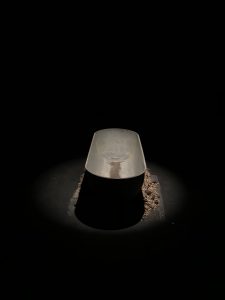
The bath was a centric part of the process, the set, and the staging of the piece. It was a way of queering, cripping and layering material and research undertaken and made during researching Bent.
Originally, in Bent, Horst dies by throwing his hat against an electric fence, which he was ordered to do by an SS Captain. However, due to practicalities, and the focus of the process being to queer and crip the play, we removed the electric fence, and changed it to a river/bath. The idea of the river first came about during the early explorations into the finale scene- which we explored first. We planned to contextualise the play and bring it into the here and now- York in 2018. However, this failed, it felt dramaturgically incorrect and unessecary, So, the bath became a literal bath of water. It served many purposes, like water does- it sustains life, it is a way of death (drownings, floods etc), but it is also cleansing and purifying.
The use of the bath also invited illicit queering of the material, and allowed queer images to form- Paul and I had taken inspiration from Michelangelo’s Pietà, and queered it from being the body of Jesus, in his mother Mary’s lap after the crucifixion, to Max, holding his lover Horst’s body in the bath after he was drowned, which was not only queering the image through being two men in a bath, which is the queering at it’s simplest form, but it is two men, persecuted for their sexuality, their existence being a contradiction of Hitler and the Nazi regime’s desire to have a pure Aryan race. The image was brought to life with Max (Paul) counting to ten slowly before we break the image, and begin another scene, another interaction, another stare into each others eyes, another slow break of hands touching, an interlude of wordplay influenced by Emma Bennett.
Emma Bennet’s wordplay was another method of queering/cripping the material; as it was a slippage, an intervention into a different territory, not David and Paul, not Max and Horst. We used ten words from the scenes to create the interlude, to give a small peek into the territory of the next scene, but until the scene is performed the audience are left unaware of what these words actually mean; they could simply be be what we are feeling, words that come into our heads, which was the original meaning behind Bennet’s strategy.
The bath also assisted in the choreographing and plotting of our movement around the space, as we had two rows of chairs down both sides of the studio, and the bath in the middle, when we wanted to get from one side to the other we would go full circle around the space, down the aisles between the rows of chairs at either side. This monotonous, cyclical movement, especially during the second scene where we are moving bags of rocks for the majority of time, reflects the daily life in the concentration camps; the same tasks, the same way, no variety, working until you’re either dead, or one of the lucky ones to survive the camps and be liberated. In process, it felt almost robotic, stagnant like we were not getting anywhere in terms of developing, but it was realised that actually by doing this movement, we were reflecting the constant work that those in the camps would be undertaking while queering and cripping the scene by stopping and starting, breaking movement with looks at one another, stopping mid way to pick up stones we had dropped.